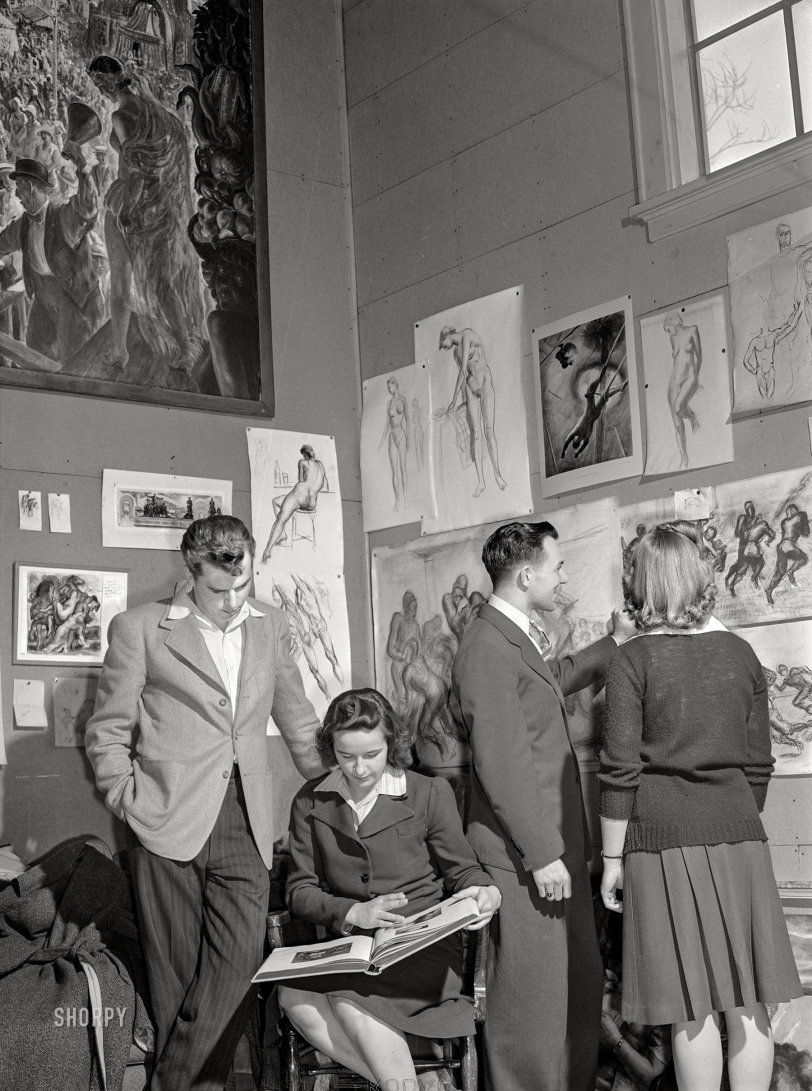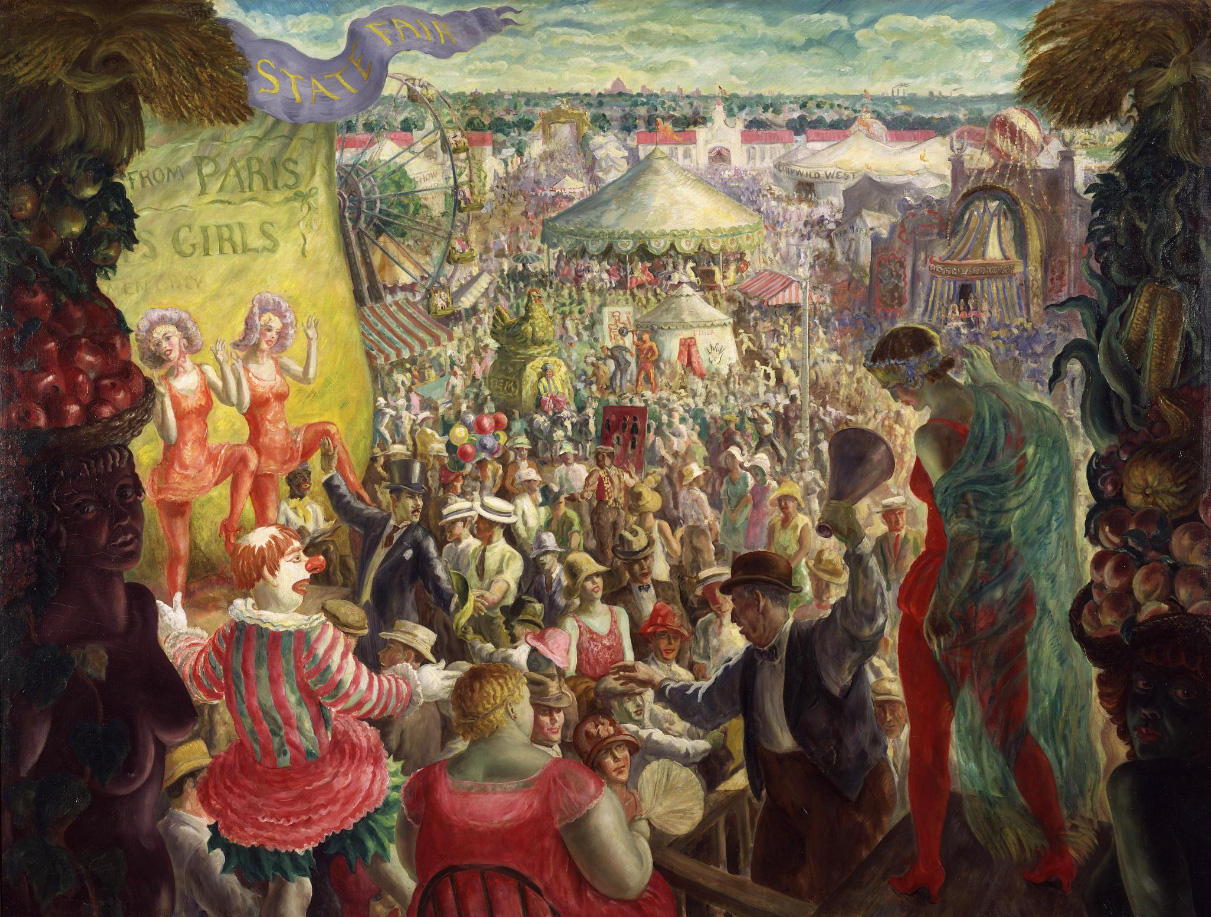


Framed or unframed, desk size to sofa size, printed by us in Arizona and Alabama since 2007. Explore now.
Shorpy is funded by you. Patreon contributors get an ad-free experience.
Learn more.

- What a headache!
- Baldwin 62303
- Baldwin VO-1000
- Cold
- No expense spared
- Tough Guys
- Lost in Toyland
- And without gloves
- If I were a blindfolded time traveler
- Smoke Consumer Also Cooks
- Oh that stove!
- Possibly still there?
- What?!?
- $100 Reward
- Freeze Frame
- Texas Flyer wanted
- Just a Year Too Soon
- WWII -- Replacing men with women at the railroad crossing.
- Yes, Icing
- You kids drive me nuts!
- NOT An Easy Job
- I wonder
- Just add window boxes
- Icing Platform?
- Indiana Harbor Belt abides
- Freezing haze
- Corrections (for those who care)
- C&NW at Nelson
- Fallen Flags
- A dangerous job made worse
Print Emporium
Figure Studies: 1942

April 1942. "Madison, Wisconsin. Members of the University of Wisconsin's Blue Shield Country Life Club visiting the studio of John Steuart Curry, university artist-in-residence. One of the aims of the club is to bring about greater participation in cultural activities among farm people." Acetate negative by Jack Delano, U.S. Foreign Information Service. View full size.
Was the photo edited?
If you look at the right hand of the woman seated in this photo - and in the one another commenter linked to - it appears that she was smoking a cigarette, but that the offensive object was photo-shopped out of the image at some point. Which does raise a question as to whether the artwork was edited too.
[Um, no. And no. - Dave]
Elephants
Since it's in an artist's studio, it is "art". Otherwise it would be smut.
Elephant in the room --
I am chuckling at the posters' varied comments on drywall -- drywall?
For pity's sake fellows, there are *naked people* on the walls.
Yes, gypsum lath ...
I put up a lot of it for plaster walls in the 1950s and '60s. It was a simple job that a kid could do without consequential mistakes. Our lath was solid (non-perforated) but held the plaster well, probably because the outer layer of paper was fuzzy. I know it worked because the plaster walls in one house I prepped are still in fine condition after 62 years.
The lath sheets were 18x48 inches and fit well with studs on either 16- or 24-inch centers. Wall studs in the pictured room are on more expensive 16-inch centers as indicated by the nail spacing. The walls were probably always intended to be tack boards and never finished with plaster, which would have been done before the window trim was applied.
Drywall sheets came later, had a smooth finish for painting, were thicker, and of course were typically 4x8 feet. The plastering trade gradually disappeared after the innovation of drywall, and with it the fine decorative finishes that one sometimes can find in old houses. Plaster was more expensive and took a long time to dry, which held up the construction process.
Deja vu Agri Culture
I thought this group and setting looked familiar. Sometimes, I'm amazed by what I remember ... but, don't ask me what I ate for dinner last night.
From the days before the drywall we know today
Those small rectangular sheets, often generically referred to as "sheetrock" (after the United States Gypsum Company trademarked brand Sheetrock) were commonly used before the advent of the standard, larger sheets in later years.
A variation of this product was one of similar size called rock lath and was used in cases where a plaster coat was desired. This had perforations to allow the plaster to form "keys" in the same manner as in older construction that relied on the use of wood lath strips with spaces in between to receive the wet plaster. When dried, the plaster would be locked in place where it had been pressed through the strips.
Cultural Rift
Farm life is a culture in itself. These days, the trend of modern homesteading, farm B&B experiences, the resurgence of vegetable gardening, and food preservation is often portrayed as aspirational - absurdly glossy and sometimes morally superior, which I find ridiculous.
Thinking of my two sets of grandparents, all farmers in the Midwest from the 19-teens to the 1960s, and first-generation Americans, my mother's family was very much immersed in the cultural offerings available to them, while my father's side was deeply superstitious and suspicious of "outsiders." Both sides had their good qualities and flaws, but the difference in "worldliness" between these families who were in like occupations, of similar economic status, and living in the same general area is marked. How much or how little the two families embraced broader cultural experiences is vastly different.
My mother's immediate and extended family was very well read, made trips to museums and concerts, and attended lectures when they could, were involved in local civic organizations and school boards, had leadership roles in agricultural and conservation organizations, and their churches. There was a desire to acquire new skills, and to modernize the farm. They hosted foreign students who were attending a local university in the 1940s and '50s, and maintained correspondence with those students for decades after.
Conversely, my father's family, who we lived closer to, was quite insular. Any unfamiliar vehicle that came down the road was the topic of endless speculation, and even unease. They gossiped with glee, and could fire up the righteous indignation at the drop of a hat. They did possess some musical talent, but it was not shared beyond the family or church. Oddly, no one offered to teach us grandkids guitar or piano, nor invited us to sing - we were watchers only. We grandkids did learn a bit about raising animals, gardening, and preserving food, but the methods were static, stuck in a former era. Agricultural practices were never updated. Unsurprisingly, no one took up farming, and the land was leased to other farmers after my grandparents retired.
Fair Enough
I am interested in the large work on the wall above them. Anyone know what that is? Might it be a Curry? Ah, yes it is "State Fair," and in color!

























On Shorpy:
Today’s Top 5